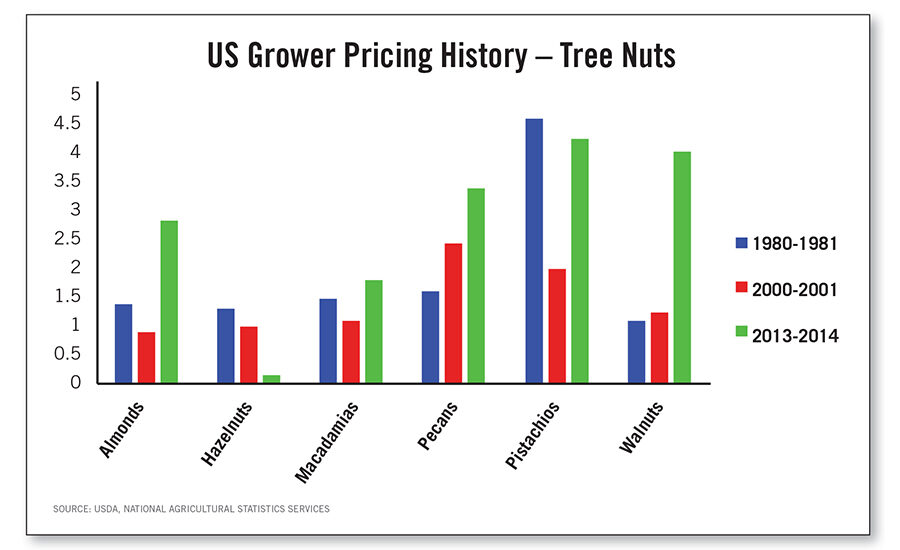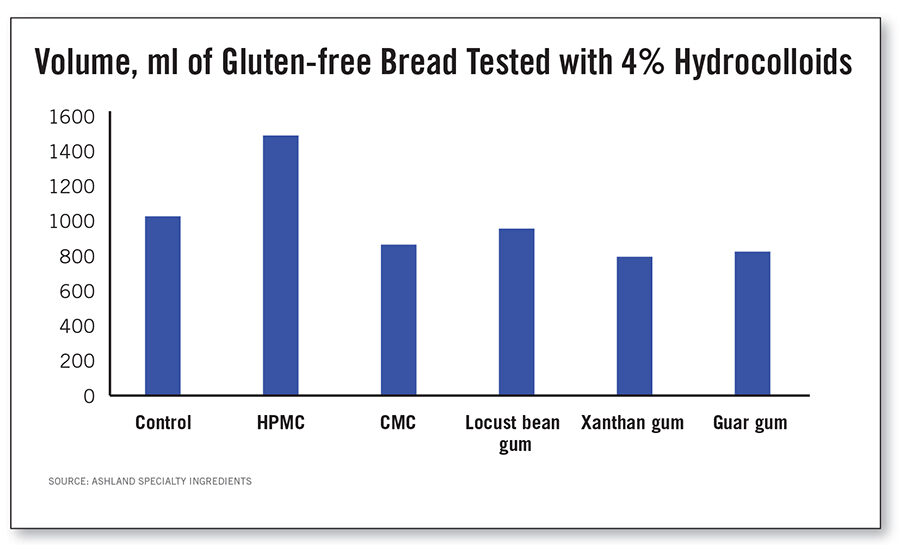Food Allergies: Formulation Challenges
Formulations for those affected with food allergies is a growing concern for all aspects of the food/beverage industry. Prepared Foods’ R&D Seminar speakers discussed two of the biggest challenges: formulating nut-free foods and formulating for gluten-free

Nut prices have fluctuated over the years, due to many factors including weather, water, disease, crop yields, grades, demand and government intervention. Prices below are what growers receive; consumer prices would be much higher. Currently, the pecan market is very tight, and prices are very high now. Almonds have come down slightly, and walnuts have come down significantly, continuing to show the extreme volatility in pricing for all nuts.

HPMC both showed better volume than other hydrocolloids or the control at 4% use level.


Formulating Nut-free Foods
Nuts are an important source of nutrients for both humans and wildlife. Because of their high oil and protein content, they are a highly prized food and energy source. Applications for nuts are countless; they include bakery products and mixes, confectionery, snacks, trail mixes, dairy and ice cream, and much more.
Nuts have many features that are appealing for foods, such as wide variety, eye appeal, flavor, texture, convenience, nutrition and availability—and they can be somewhat inexpensive. Nutritionally, nuts provide healthy fat, protein and fiber, as well as a number of vitamins and minerals.
Overall, per capita consumption of tree nuts has increased steadily over the years, going from 1.82lbs in 1981 to over 4lbs in 2014 (not including peanuts). However, the nut market can be volatile, due to weather, water, disease, crop yields, grades, demand and government intervention.
“Nuts are one of the largest users of water in California, and most are exported,” noted Dennis Reid, vice president of business development, Inclusion Technologies, in his Prepared Foods’ R&D Seminar presentation titled “Formulating Nut-free Foods.”
Nut allergies have contributed to the market for allergy and intolerance products, worth $3.9 billion in 2015 according to Packaged Facts. Because of allergies, schools and restaurants have been forced to react to this growing and sometimes fatal concern. People with allergies can call some airlines the day before and have peanuts removed from their flight.
Often, foods carry a warning that they have been produced in a facility that contains nuts, making their consumption a big risk to those with nut allergies. Some nut-allergic individuals carry a “Dining Safely Card” explaining their allergies and asking restaurant staff to check ingredient statements and help ensure they do not consume even a minute amount of nuts. The card also asks that if the person does accidentally consume any nuts, to please have someone call 911, as they will require immediate medical attention.
According to Reid, “Formulation approaches for replacing or extending nuts include avoiding nut-based recipes, using fewer nuts, adding nut flavors, or using nut extenders or nut replacers.” Nut alternatives or formulated nut analogs can have the sensory characteristics of tree nuts, including appearance, taste and texture. They can function similarly in food systems, as well, as do nuts themselves.
Nut analogs are economical versus tree nuts, and there is a consistent supply, allowing for 100% nut-free products with similar compositions to nut-containing counterparts. Nut analogs are easily digested; have a wide range of nut flavors; various sizes and shapes; and no micro concerns (as nuts sometimes do).
In summary, Reid adds, “Nuts are excellent food ingredients, but are getting very expensive, and nut allergies are not going away. There are solutions for food scientists’ consideration in nut extension or replacement. And functionality does not have to be lost.”
“Formulating Nut-free Foods, Dennis Reid, vice president of business development, Inclusion Technologies, 913-370-8070, dreid@inclusiontech.com
—Summary by Elizabeth Pelofske, Contributing Editor
Gluten-free Bread Solutions with HPMC
Today’s estimates are that 1% of the population has celiac disease; 0.4% have a life-threatening wheat allergy; 18 million people have a non-celiac wheat sensitivity; and 30% of the population currently uses gluten-free products. Global gluten-free introductions continue to show strong growth, according to the Natural Marketing Institute.
Since 1999, gluten-free food and beverage launches have grown each year to a total of over 17,000 products in the US by 2014; globally, that’s more than 79,000 gluten-free product launches. Gluten-free product launches have been seen in many categories—with the most in snacks, dairy, sauces and seasonings, and bakery.
Gluten is the protein fraction in wheat, made up of two proteins, glutenin and gliadin. They function in baked goods to provide extensibility (the ability of dough to stretch); gas-holding ability, giving bread an open structure, rise and volume; and structure (the ability to retain a three-dimensional network).
“Gluten-free or wheat-free baked goods are difficult to formulate and to achieve the properties of their wheat-based counterparts,” stated Jo Anna Popielarski, scientist, Food R&D & Technical, Ashland Specialty Ingredients, in her PF R&D Seminar titled “Gluten-free Bread Solutions with HPMC.”
Formulation challenges include poor height and volume, poor texture and eating properties, inconsistent crumb structure and short shelflife. Typically, bakers will use one or more hydrocolloid to help achieve the desired characteristics in gluten-free baked goods. Xanthan gum, guar gum, sodium carboxymethylcellulose (typically labeled as “cellulose gum”), locust bean gum or hydroxypropylmethylcellulose (HPMC, typically labeled as “modified cellulose”) are common.
“HPMC is the preferred hydrocolloid for gluten-free bread in Europe and North America. HPMC has been established in the scientific literature, with more than 44 citations, most in the last five years,” added Popielarski.
HPMC possesses unique properties that benefit gluten-free bread. When thermally induced gelation of HPMC in a bakery formulation occurs, the liquid transitions to a solid gel at baking temperatures, and its surface activity promotes gas cell formation. Support in scientific literature for HPMC functions in gluten-free bread include its increased water absorption, gas retention and specific volumes. Softness, finer crumb structure and reduced freeze-thaw damage also are advantages provided by HPMC. HPMC also is highly effective in egg-free formulations.
Popielarski explained that, in the US, HMPC is identified on an ingredient statement as “modified cellulose.” There are many different grades of HPMC, including a 4,000cps viscosity and a 15,000cps viscosity—which have been the most researched for gluten-free applications. These HPMC ingredients have been tested internally in rice-flour formulations and in blends of rice/tapioca/buckwheat at 2 and 4% levels. Bread volume, softness and appearance were tested. Results showed that HPMC (4,000cps) showed higher volume, increased softness and better appearance than the control and other hydrocolloids, at both 2% and 4% levels.
In conclusion, 2-4% with the 4,000cps HPMC is the best option for simplified rice-flour formulations and also provide some benefits to the flour blend.
“Gluten-free Bread Solutions with HPMC,” Jo Anna Popielarski, scientist, Food R&D & Technical, Ashland Specialty Ingredients, 302-995-3286,
japopielarski@ashland.com
—Summary by Elizabeth Pelofske, Contributing Editor
Originally appeared in the June, 2016 issue of Prepared Foods as Food Allergies: Formulation Challenges.
Looking for a reprint of this article?
From high-res PDFs to custom plaques, order your copy today!






